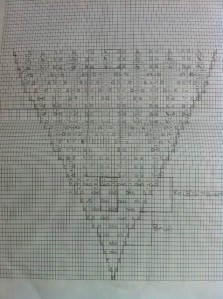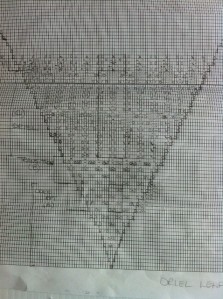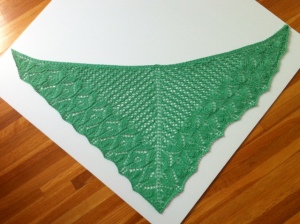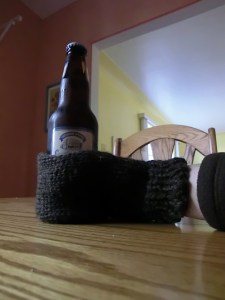I thought it might be fun to re-post this from my project page on Craftsy.com – which is an amazing site if you’re interested in learning something new, be it about knitting, crochet, quilting, sewing, baking cakes, photography, and so on. Even though I work in the Arts, it’s not often I get to create something like this, and learning how to design a lace shawl opened a lot of new thought pathways for me. …and it was a lot of fun!
Of the stitch patterns mentioned in this design, the Miniature Leaf pattern came from the pattern for the Little Silk Shrug in Lace Style (published by Interweave Press), and the Oriel pattern comes from Barbara G. Walker’s Second Treasury of Knitting Patterns (THE definitive stitch dictionary in my opinion – if you’re only going to have one, this should be it).
The first attempt at this top-down triangular shawl, as illustrated by the 1st chart (see photos below) and swatch/sample, worked fine for the Miniature Leaf pattern in the centre, but did not work when I switched to the Oriel pattern, which turned out not to be symmetrical, despite the fact that the increase rate worked well for both patterns (1, 1, 2, 2) (see detail photo – yikes!). Back to the chart to fix it…

The first chart – looks okay, but it wasn’t when I knit it.

Definitely NOT symmetrical! Back to the “charting” board.
The second chart turned out better (see photo), with both stitch patterns symmetrical in each triangular wedge. I also made a better transition to the border, continuing the purl stitches into the border rows. However, the border on this attempt didn’t seem work as well – it isn’t as “pointy” as the first sample, but I’m not too bothered about that, as the other stitch patterns turned out well. Perhaps I would need to add more border rows to make the border more “pointy”?

The revised project chart – now it should work!

Success! Both sides look the same.
When I come to knit it again, I will make the centre larger and use a wool or wool blend fingering weight yarn that will hold the blocking better than the cotton I used here – and that is in a colour I like better. The stitch definition of the cotton is wonderful, but cotton doesn’t hold blocking well, and I don’t think I’d want to keep having to re-block it.
It was a really enjoyable journey and now I’m working on another design for a triangular shawl that has a thistle motif to reflect my Scottish heritage. When I come to knit that one, I will post on my progress here.





